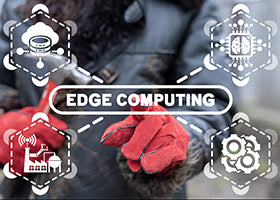
By Jeff Sigua, Product Manager
Tires screeching to a halt, your car’s edge computer has predicted a collision warning and acted according to its scripted protocol without communication to a network. Edge computers of all sizes are taking the power of the data center and access of the cloud into environments where sensors and/or cameras are located.
Why is the speed important with on-premises edge computing? It’s already part of our everyday lives. One of the most common everyday features can be found in the cars we drive today. Multiple sensors and calculations are occurring every millisecond as you drive to work, school or the store. Sensor data is reading current speed, load, road gradient, and tire slippage, all while radar sensors buffer the perimeter to calculate incoming objects. If an incident occurs, programmed scripts, AI or machine learning, is taking over before the human brain and muscle reflexes can react, which will vary depending on brand of car you own. These may be programed to make direction changes if one or more of the sensors detect something in its path. This may be used to stop abruptly or weave out of harm’s way. Kelly Blue Book states that there has been a 50% reduction in frontal collisions with these smart safety systems in place. The stats also show 23% less lane change collisions that result in injury.
While passenger vehicles are limited to size and number of sensors required to cover the perimeter field, these require smaller compute power and sensor network. Larger and heavier vehicles such as planes, tractors, ships, and semi-trucks would demand larger and stronger edge computer appliances to handle the data ingest and processing power. The AI Transportable applications' radar/camera field in these vehicles are much larger in scale, with calculation speeds demanding faster results. Sensor data must be ingested, conditioned, and converted to digital, then run through application algorithms, and finally sent to a communication device for the pending actions.

As a car enthusiast, it was common practice for the past couple of decades to have a laptop connected to the OBD2 port. This was used to log & adjust fuel maps, fuel injector duty cycles at pending RPM and boost with turbo-powered cars, while the car is strapped to a dyno machine. The larger scale sensor ingest requirements above are much more demanding than what a 200-watt laptop may offer.
Mobile supercomputers are the trend with edge computers in the AI Transportable part of the market, pushing datacenter power to the sensor location. Unfortunately, standard computers made by many suppliers can’t deal with the challenges, including heat, power availability, and rugged shock & vibe.
Fortunately, One Stop Systems (OSS) is 100% focused on this fast growing multi-billion dollar need. For example, OSS’ Gen 4 rugged servers consume upwards of 2600 watts of compute power at the edge and offer both AMD and Intel flavors. These 3U SDS (short depth sever) allows end users to add GPU, networking, and custom FPGA sensor ingest PCIe cards, in order to customize for each AI Transportable need. Although many of these applications require high-performance compute and memory within the vehicle, there are also demands to move large amounts of the collected data into the cloud for additional analysis and compute. Wireless and even the highest speed wired networks can’t move the data fast enough without holding up the truck, plane, or ship. This drives the need for quick and easy access to removable memory. For example, in trucks, this is on the side of the vehicle.
OSS serves this need with high-density storage platforms, including the half rack width Centuari, which has hot swappable sleds that slide out quickly and can be physically carried to an OSS server that supports this sled form factor and capability. This Centuari storage unit, located on the side of the truck, connects back to the supercomputer and main storage unit via mSAS cables, leveraging the speed and OSS’s strength in PCIe Gen 4. This allows the data to be uploaded while the truck is back on the road. Whether it is a truck, plane, or ship, it does not make money when it is not moving.
Click the buttons below to share this blog post!
Comments will be approved before showing up.


